Indigenous Education and Perspective
VerifiedAdded on 2023/04/21
|9
|2061
|257
AI Summary
This article explores the importance of indigenous education and perspective through art and activism. It discusses the artwork of Tony Albert and the message he conveys about the exploitation of indigenous people. The article also highlights the rich culture and history of indigenous peoples in Australia.
Contribute Materials
Your contribution can guide someone’s learning journey. Share your
documents today.
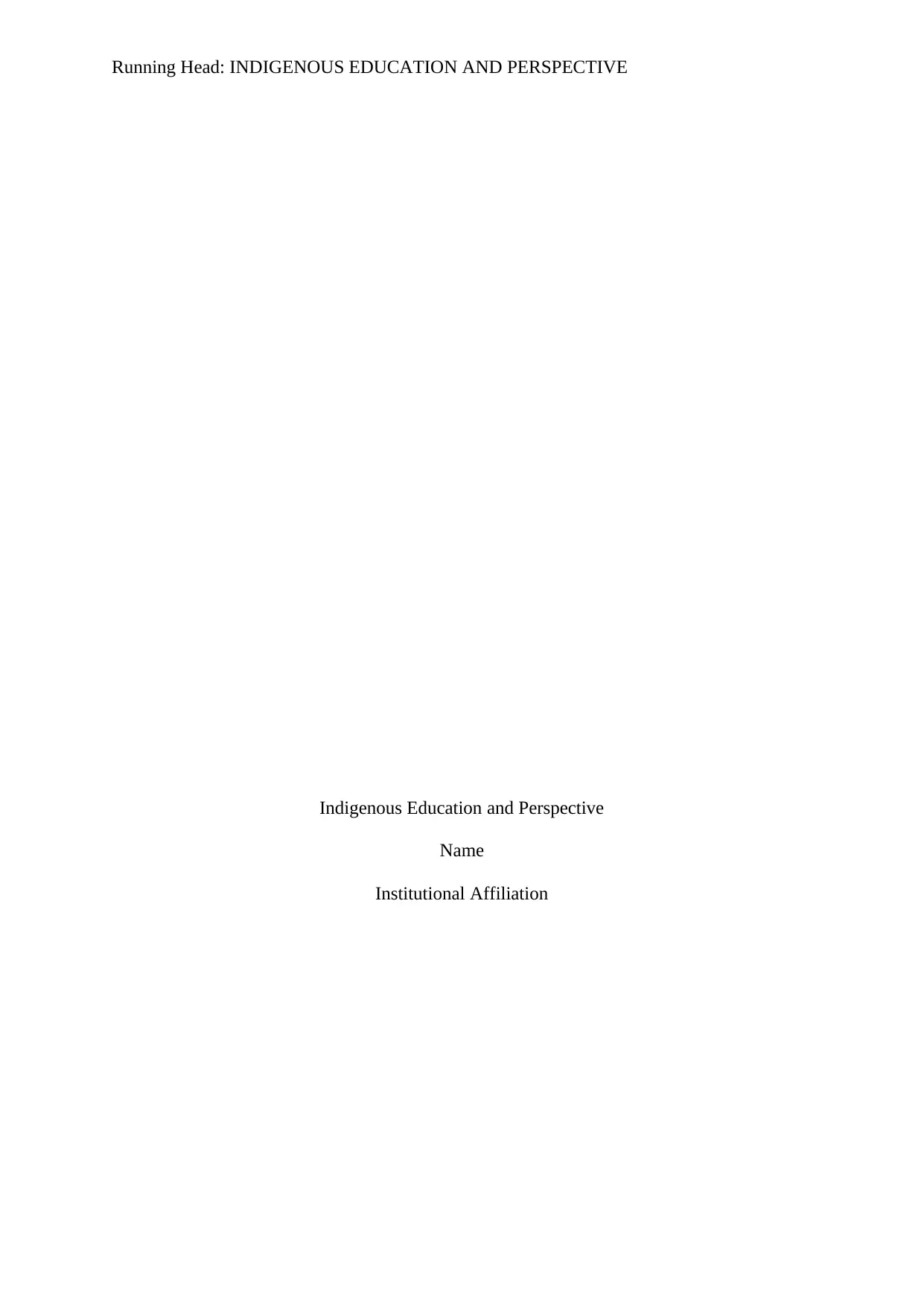
Running Head: INDIGENOUS EDUCATION AND PERSPECTIVE
Indigenous Education and Perspective
Name
Institutional Affiliation
Indigenous Education and Perspective
Name
Institutional Affiliation
Secure Best Marks with AI Grader
Need help grading? Try our AI Grader for instant feedback on your assignments.
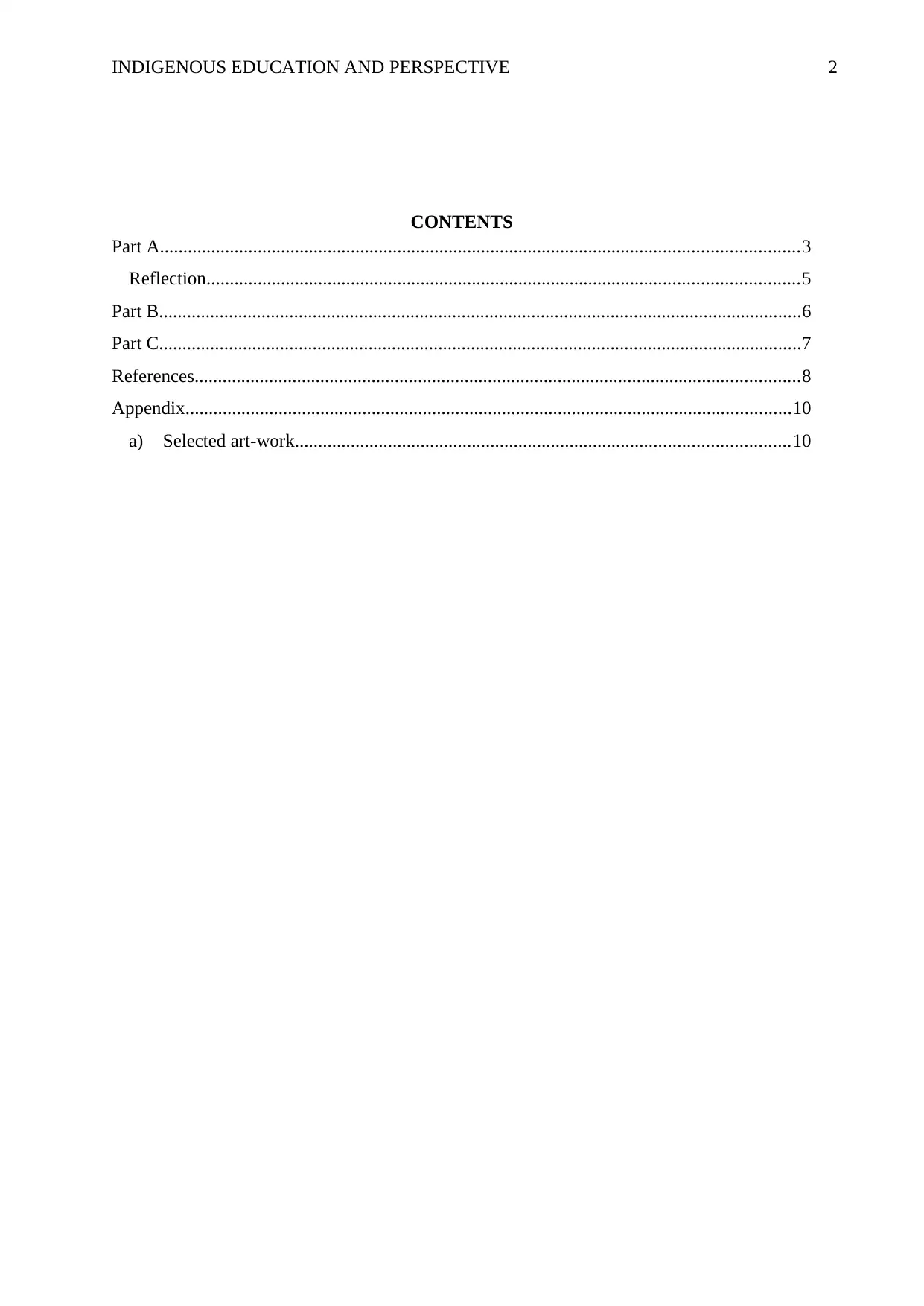
INDIGENOUS EDUCATION AND PERSPECTIVE 2
CONTENTS
Part A.........................................................................................................................................3
Reflection...............................................................................................................................5
Part B..........................................................................................................................................6
Part C..........................................................................................................................................7
References..................................................................................................................................8
Appendix..................................................................................................................................10
a) Selected art-work..........................................................................................................10
CONTENTS
Part A.........................................................................................................................................3
Reflection...............................................................................................................................5
Part B..........................................................................................................................................6
Part C..........................................................................................................................................7
References..................................................................................................................................8
Appendix..................................................................................................................................10
a) Selected art-work..........................................................................................................10
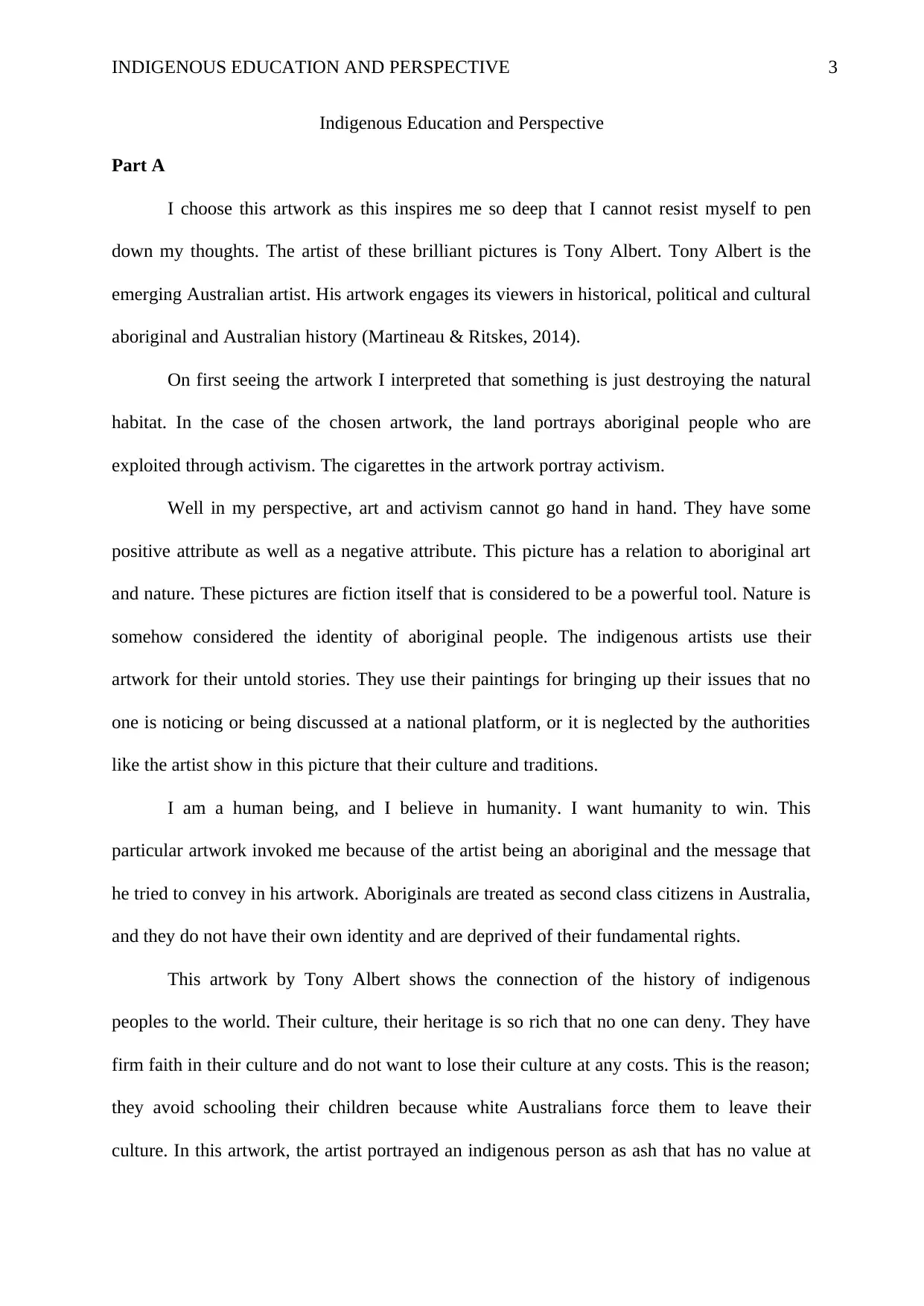
INDIGENOUS EDUCATION AND PERSPECTIVE 3
Indigenous Education and Perspective
Part A
I choose this artwork as this inspires me so deep that I cannot resist myself to pen
down my thoughts. The artist of these brilliant pictures is Tony Albert. Tony Albert is the
emerging Australian artist. His artwork engages its viewers in historical, political and cultural
aboriginal and Australian history (Martineau & Ritskes, 2014).
On first seeing the artwork I interpreted that something is just destroying the natural
habitat. In the case of the chosen artwork, the land portrays aboriginal people who are
exploited through activism. The cigarettes in the artwork portray activism.
Well in my perspective, art and activism cannot go hand in hand. They have some
positive attribute as well as a negative attribute. This picture has a relation to aboriginal art
and nature. These pictures are fiction itself that is considered to be a powerful tool. Nature is
somehow considered the identity of aboriginal people. The indigenous artists use their
artwork for their untold stories. They use their paintings for bringing up their issues that no
one is noticing or being discussed at a national platform, or it is neglected by the authorities
like the artist show in this picture that their culture and traditions.
I am a human being, and I believe in humanity. I want humanity to win. This
particular artwork invoked me because of the artist being an aboriginal and the message that
he tried to convey in his artwork. Aboriginals are treated as second class citizens in Australia,
and they do not have their own identity and are deprived of their fundamental rights.
This artwork by Tony Albert shows the connection of the history of indigenous
peoples to the world. Their culture, their heritage is so rich that no one can deny. They have
firm faith in their culture and do not want to lose their culture at any costs. This is the reason;
they avoid schooling their children because white Australians force them to leave their
culture. In this artwork, the artist portrayed an indigenous person as ash that has no value at
Indigenous Education and Perspective
Part A
I choose this artwork as this inspires me so deep that I cannot resist myself to pen
down my thoughts. The artist of these brilliant pictures is Tony Albert. Tony Albert is the
emerging Australian artist. His artwork engages its viewers in historical, political and cultural
aboriginal and Australian history (Martineau & Ritskes, 2014).
On first seeing the artwork I interpreted that something is just destroying the natural
habitat. In the case of the chosen artwork, the land portrays aboriginal people who are
exploited through activism. The cigarettes in the artwork portray activism.
Well in my perspective, art and activism cannot go hand in hand. They have some
positive attribute as well as a negative attribute. This picture has a relation to aboriginal art
and nature. These pictures are fiction itself that is considered to be a powerful tool. Nature is
somehow considered the identity of aboriginal people. The indigenous artists use their
artwork for their untold stories. They use their paintings for bringing up their issues that no
one is noticing or being discussed at a national platform, or it is neglected by the authorities
like the artist show in this picture that their culture and traditions.
I am a human being, and I believe in humanity. I want humanity to win. This
particular artwork invoked me because of the artist being an aboriginal and the message that
he tried to convey in his artwork. Aboriginals are treated as second class citizens in Australia,
and they do not have their own identity and are deprived of their fundamental rights.
This artwork by Tony Albert shows the connection of the history of indigenous
peoples to the world. Their culture, their heritage is so rich that no one can deny. They have
firm faith in their culture and do not want to lose their culture at any costs. This is the reason;
they avoid schooling their children because white Australians force them to leave their
culture. In this artwork, the artist portrayed an indigenous person as ash that has no value at
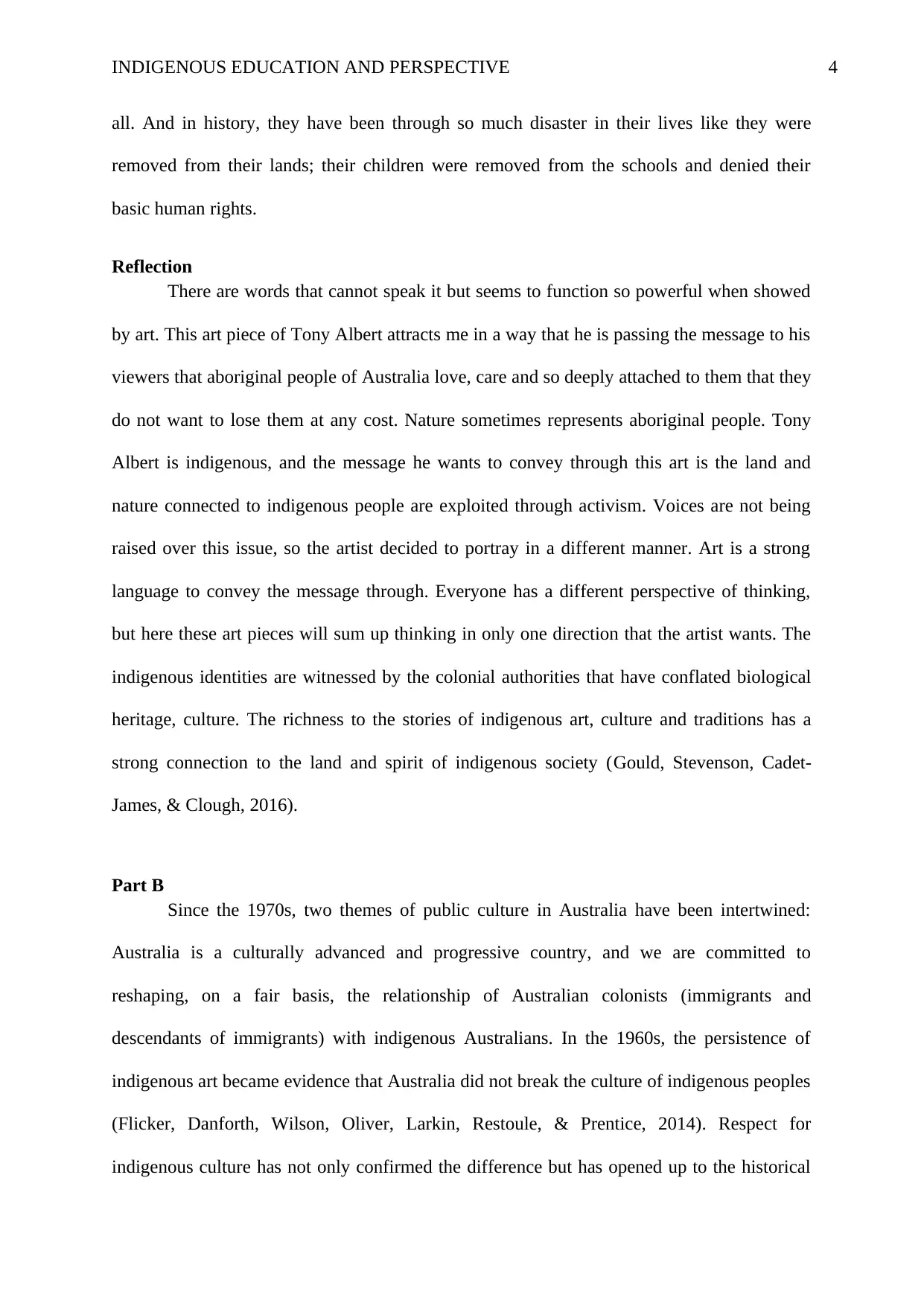
INDIGENOUS EDUCATION AND PERSPECTIVE 4
all. And in history, they have been through so much disaster in their lives like they were
removed from their lands; their children were removed from the schools and denied their
basic human rights.
Reflection
There are words that cannot speak it but seems to function so powerful when showed
by art. This art piece of Tony Albert attracts me in a way that he is passing the message to his
viewers that aboriginal people of Australia love, care and so deeply attached to them that they
do not want to lose them at any cost. Nature sometimes represents aboriginal people. Tony
Albert is indigenous, and the message he wants to convey through this art is the land and
nature connected to indigenous people are exploited through activism. Voices are not being
raised over this issue, so the artist decided to portray in a different manner. Art is a strong
language to convey the message through. Everyone has a different perspective of thinking,
but here these art pieces will sum up thinking in only one direction that the artist wants. The
indigenous identities are witnessed by the colonial authorities that have conflated biological
heritage, culture. The richness to the stories of indigenous art, culture and traditions has a
strong connection to the land and spirit of indigenous society (Gould, Stevenson, Cadet-
James, & Clough, 2016).
Part B
Since the 1970s, two themes of public culture in Australia have been intertwined:
Australia is a culturally advanced and progressive country, and we are committed to
reshaping, on a fair basis, the relationship of Australian colonists (immigrants and
descendants of immigrants) with indigenous Australians. In the 1960s, the persistence of
indigenous art became evidence that Australia did not break the culture of indigenous peoples
(Flicker, Danforth, Wilson, Oliver, Larkin, Restoule, & Prentice, 2014). Respect for
indigenous culture has not only confirmed the difference but has opened up to the historical
all. And in history, they have been through so much disaster in their lives like they were
removed from their lands; their children were removed from the schools and denied their
basic human rights.
Reflection
There are words that cannot speak it but seems to function so powerful when showed
by art. This art piece of Tony Albert attracts me in a way that he is passing the message to his
viewers that aboriginal people of Australia love, care and so deeply attached to them that they
do not want to lose them at any cost. Nature sometimes represents aboriginal people. Tony
Albert is indigenous, and the message he wants to convey through this art is the land and
nature connected to indigenous people are exploited through activism. Voices are not being
raised over this issue, so the artist decided to portray in a different manner. Art is a strong
language to convey the message through. Everyone has a different perspective of thinking,
but here these art pieces will sum up thinking in only one direction that the artist wants. The
indigenous identities are witnessed by the colonial authorities that have conflated biological
heritage, culture. The richness to the stories of indigenous art, culture and traditions has a
strong connection to the land and spirit of indigenous society (Gould, Stevenson, Cadet-
James, & Clough, 2016).
Part B
Since the 1970s, two themes of public culture in Australia have been intertwined:
Australia is a culturally advanced and progressive country, and we are committed to
reshaping, on a fair basis, the relationship of Australian colonists (immigrants and
descendants of immigrants) with indigenous Australians. In the 1960s, the persistence of
indigenous art became evidence that Australia did not break the culture of indigenous peoples
(Flicker, Danforth, Wilson, Oliver, Larkin, Restoule, & Prentice, 2014). Respect for
indigenous culture has not only confirmed the difference but has opened up to the historical
Secure Best Marks with AI Grader
Need help grading? Try our AI Grader for instant feedback on your assignments.
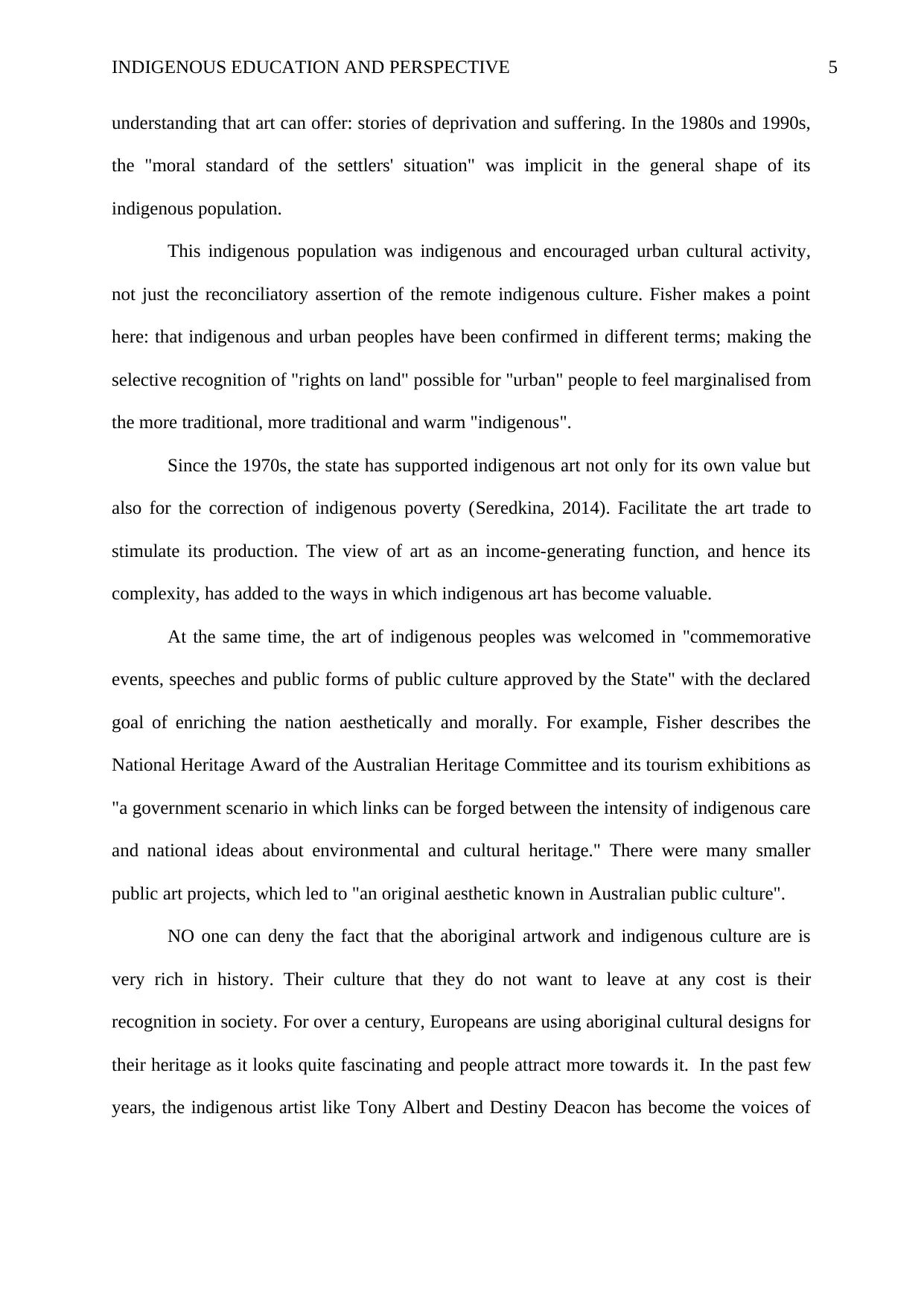
INDIGENOUS EDUCATION AND PERSPECTIVE 5
understanding that art can offer: stories of deprivation and suffering. In the 1980s and 1990s,
the "moral standard of the settlers' situation" was implicit in the general shape of its
indigenous population.
This indigenous population was indigenous and encouraged urban cultural activity,
not just the reconciliatory assertion of the remote indigenous culture. Fisher makes a point
here: that indigenous and urban peoples have been confirmed in different terms; making the
selective recognition of "rights on land" possible for "urban" people to feel marginalised from
the more traditional, more traditional and warm "indigenous".
Since the 1970s, the state has supported indigenous art not only for its own value but
also for the correction of indigenous poverty (Seredkina, 2014). Facilitate the art trade to
stimulate its production. The view of art as an income-generating function, and hence its
complexity, has added to the ways in which indigenous art has become valuable.
At the same time, the art of indigenous peoples was welcomed in "commemorative
events, speeches and public forms of public culture approved by the State" with the declared
goal of enriching the nation aesthetically and morally. For example, Fisher describes the
National Heritage Award of the Australian Heritage Committee and its tourism exhibitions as
"a government scenario in which links can be forged between the intensity of indigenous care
and national ideas about environmental and cultural heritage." There were many smaller
public art projects, which led to "an original aesthetic known in Australian public culture".
NO one can deny the fact that the aboriginal artwork and indigenous culture are is
very rich in history. Their culture that they do not want to leave at any cost is their
recognition in society. For over a century, Europeans are using aboriginal cultural designs for
their heritage as it looks quite fascinating and people attract more towards it. In the past few
years, the indigenous artist like Tony Albert and Destiny Deacon has become the voices of
understanding that art can offer: stories of deprivation and suffering. In the 1980s and 1990s,
the "moral standard of the settlers' situation" was implicit in the general shape of its
indigenous population.
This indigenous population was indigenous and encouraged urban cultural activity,
not just the reconciliatory assertion of the remote indigenous culture. Fisher makes a point
here: that indigenous and urban peoples have been confirmed in different terms; making the
selective recognition of "rights on land" possible for "urban" people to feel marginalised from
the more traditional, more traditional and warm "indigenous".
Since the 1970s, the state has supported indigenous art not only for its own value but
also for the correction of indigenous poverty (Seredkina, 2014). Facilitate the art trade to
stimulate its production. The view of art as an income-generating function, and hence its
complexity, has added to the ways in which indigenous art has become valuable.
At the same time, the art of indigenous peoples was welcomed in "commemorative
events, speeches and public forms of public culture approved by the State" with the declared
goal of enriching the nation aesthetically and morally. For example, Fisher describes the
National Heritage Award of the Australian Heritage Committee and its tourism exhibitions as
"a government scenario in which links can be forged between the intensity of indigenous care
and national ideas about environmental and cultural heritage." There were many smaller
public art projects, which led to "an original aesthetic known in Australian public culture".
NO one can deny the fact that the aboriginal artwork and indigenous culture are is
very rich in history. Their culture that they do not want to leave at any cost is their
recognition in society. For over a century, Europeans are using aboriginal cultural designs for
their heritage as it looks quite fascinating and people attract more towards it. In the past few
years, the indigenous artist like Tony Albert and Destiny Deacon has become the voices of
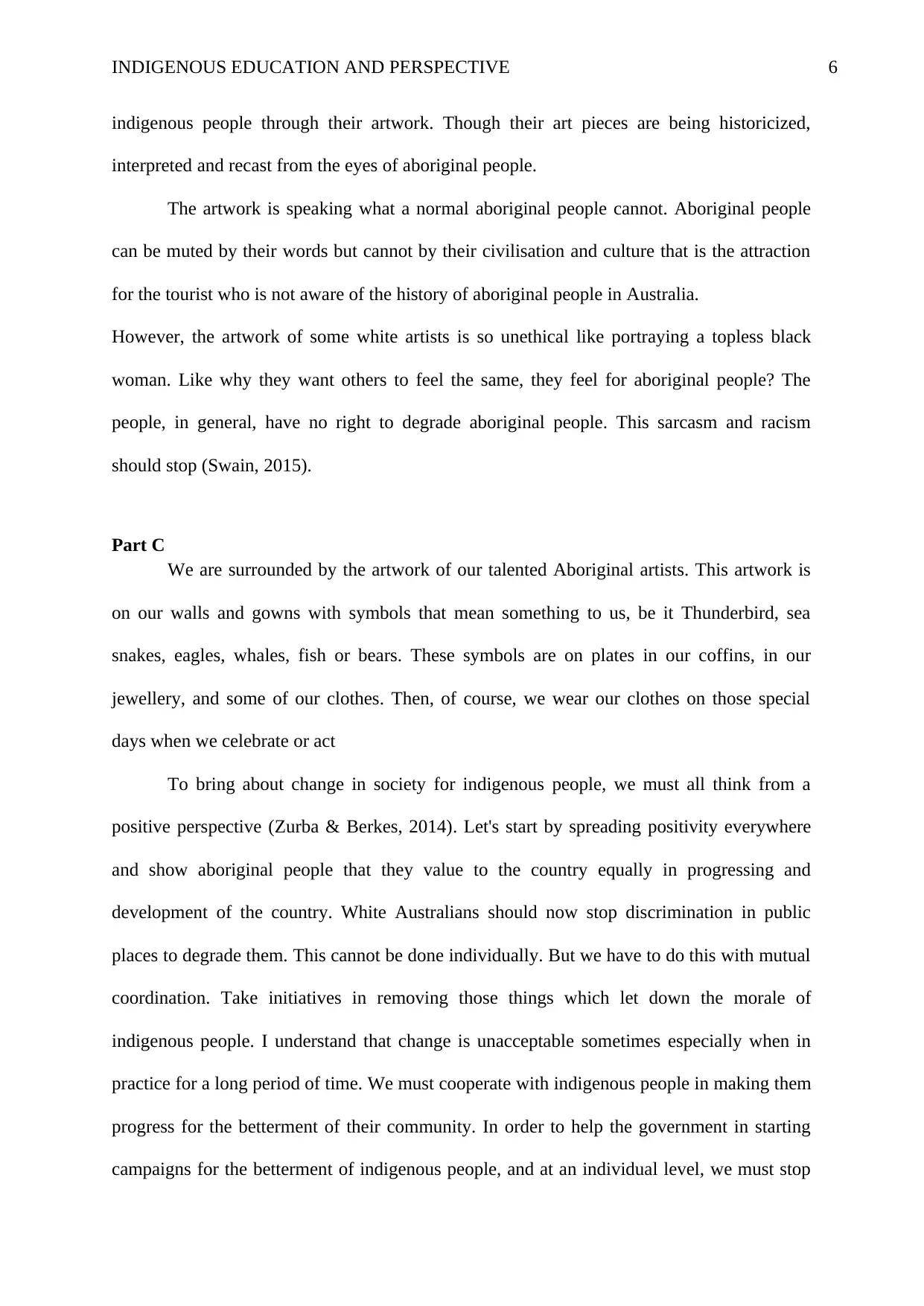
INDIGENOUS EDUCATION AND PERSPECTIVE 6
indigenous people through their artwork. Though their art pieces are being historicized,
interpreted and recast from the eyes of aboriginal people.
The artwork is speaking what a normal aboriginal people cannot. Aboriginal people
can be muted by their words but cannot by their civilisation and culture that is the attraction
for the tourist who is not aware of the history of aboriginal people in Australia.
However, the artwork of some white artists is so unethical like portraying a topless black
woman. Like why they want others to feel the same, they feel for aboriginal people? The
people, in general, have no right to degrade aboriginal people. This sarcasm and racism
should stop (Swain, 2015).
Part C
We are surrounded by the artwork of our talented Aboriginal artists. This artwork is
on our walls and gowns with symbols that mean something to us, be it Thunderbird, sea
snakes, eagles, whales, fish or bears. These symbols are on plates in our coffins, in our
jewellery, and some of our clothes. Then, of course, we wear our clothes on those special
days when we celebrate or act
To bring about change in society for indigenous people, we must all think from a
positive perspective (Zurba & Berkes, 2014). Let's start by spreading positivity everywhere
and show aboriginal people that they value to the country equally in progressing and
development of the country. White Australians should now stop discrimination in public
places to degrade them. This cannot be done individually. But we have to do this with mutual
coordination. Take initiatives in removing those things which let down the morale of
indigenous people. I understand that change is unacceptable sometimes especially when in
practice for a long period of time. We must cooperate with indigenous people in making them
progress for the betterment of their community. In order to help the government in starting
campaigns for the betterment of indigenous people, and at an individual level, we must stop
indigenous people through their artwork. Though their art pieces are being historicized,
interpreted and recast from the eyes of aboriginal people.
The artwork is speaking what a normal aboriginal people cannot. Aboriginal people
can be muted by their words but cannot by their civilisation and culture that is the attraction
for the tourist who is not aware of the history of aboriginal people in Australia.
However, the artwork of some white artists is so unethical like portraying a topless black
woman. Like why they want others to feel the same, they feel for aboriginal people? The
people, in general, have no right to degrade aboriginal people. This sarcasm and racism
should stop (Swain, 2015).
Part C
We are surrounded by the artwork of our talented Aboriginal artists. This artwork is
on our walls and gowns with symbols that mean something to us, be it Thunderbird, sea
snakes, eagles, whales, fish or bears. These symbols are on plates in our coffins, in our
jewellery, and some of our clothes. Then, of course, we wear our clothes on those special
days when we celebrate or act
To bring about change in society for indigenous people, we must all think from a
positive perspective (Zurba & Berkes, 2014). Let's start by spreading positivity everywhere
and show aboriginal people that they value to the country equally in progressing and
development of the country. White Australians should now stop discrimination in public
places to degrade them. This cannot be done individually. But we have to do this with mutual
coordination. Take initiatives in removing those things which let down the morale of
indigenous people. I understand that change is unacceptable sometimes especially when in
practice for a long period of time. We must cooperate with indigenous people in making them
progress for the betterment of their community. In order to help the government in starting
campaigns for the betterment of indigenous people, and at an individual level, we must stop
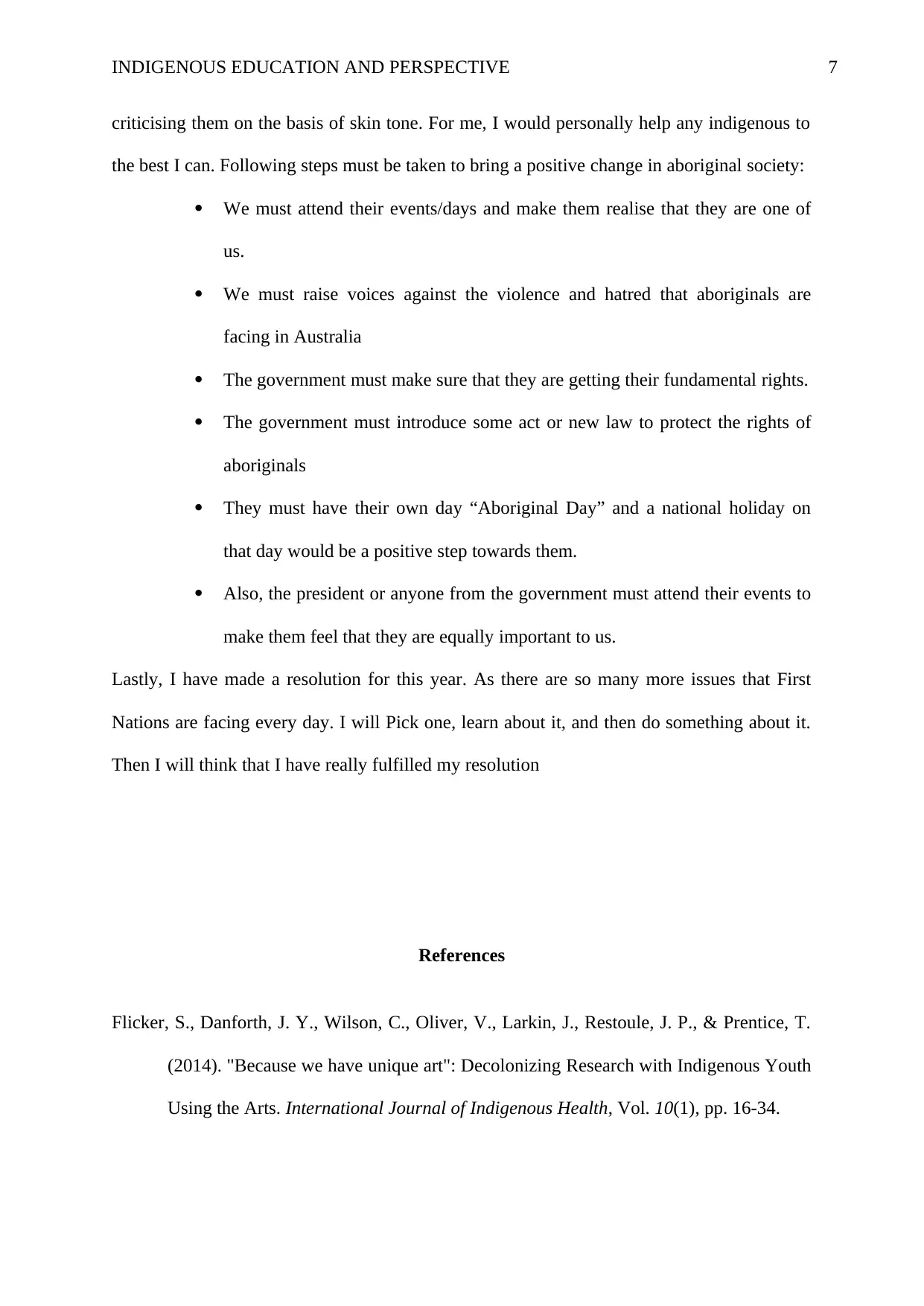
INDIGENOUS EDUCATION AND PERSPECTIVE 7
criticising them on the basis of skin tone. For me, I would personally help any indigenous to
the best I can. Following steps must be taken to bring a positive change in aboriginal society:
We must attend their events/days and make them realise that they are one of
us.
We must raise voices against the violence and hatred that aboriginals are
facing in Australia
The government must make sure that they are getting their fundamental rights.
The government must introduce some act or new law to protect the rights of
aboriginals
They must have their own day “Aboriginal Day” and a national holiday on
that day would be a positive step towards them.
Also, the president or anyone from the government must attend their events to
make them feel that they are equally important to us.
Lastly, I have made a resolution for this year. As there are so many more issues that First
Nations are facing every day. I will Pick one, learn about it, and then do something about it.
Then I will think that I have really fulfilled my resolution
References
Flicker, S., Danforth, J. Y., Wilson, C., Oliver, V., Larkin, J., Restoule, J. P., & Prentice, T.
(2014). "Because we have unique art": Decolonizing Research with Indigenous Youth
Using the Arts. International Journal of Indigenous Health, Vol. 10(1), pp. 16-34.
criticising them on the basis of skin tone. For me, I would personally help any indigenous to
the best I can. Following steps must be taken to bring a positive change in aboriginal society:
We must attend their events/days and make them realise that they are one of
us.
We must raise voices against the violence and hatred that aboriginals are
facing in Australia
The government must make sure that they are getting their fundamental rights.
The government must introduce some act or new law to protect the rights of
aboriginals
They must have their own day “Aboriginal Day” and a national holiday on
that day would be a positive step towards them.
Also, the president or anyone from the government must attend their events to
make them feel that they are equally important to us.
Lastly, I have made a resolution for this year. As there are so many more issues that First
Nations are facing every day. I will Pick one, learn about it, and then do something about it.
Then I will think that I have really fulfilled my resolution
References
Flicker, S., Danforth, J. Y., Wilson, C., Oliver, V., Larkin, J., Restoule, J. P., & Prentice, T.
(2014). "Because we have unique art": Decolonizing Research with Indigenous Youth
Using the Arts. International Journal of Indigenous Health, Vol. 10(1), pp. 16-34.
Paraphrase This Document
Need a fresh take? Get an instant paraphrase of this document with our AI Paraphraser
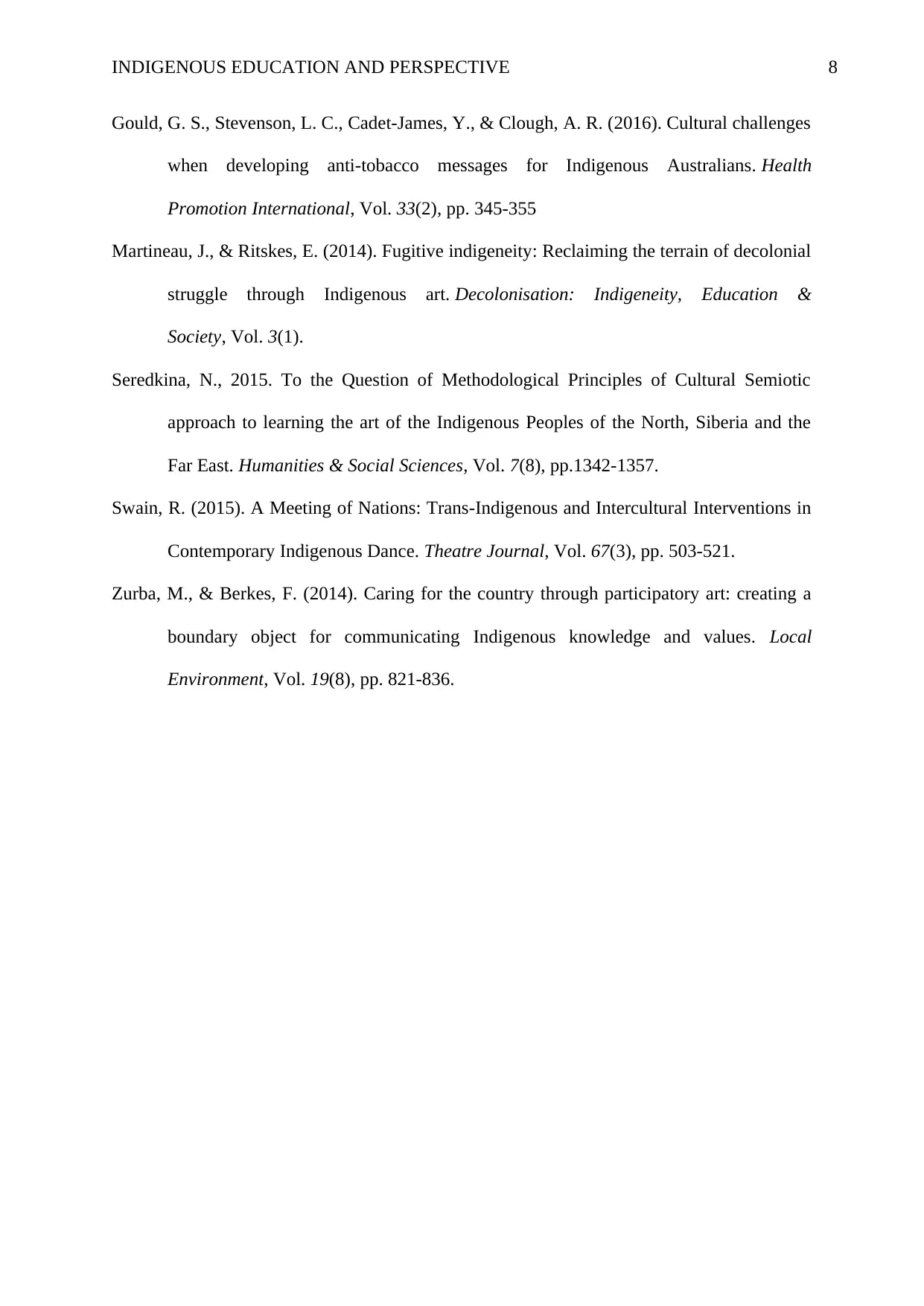
INDIGENOUS EDUCATION AND PERSPECTIVE 8
Gould, G. S., Stevenson, L. C., Cadet-James, Y., & Clough, A. R. (2016). Cultural challenges
when developing anti-tobacco messages for Indigenous Australians. Health
Promotion International, Vol. 33(2), pp. 345-355
Martineau, J., & Ritskes, E. (2014). Fugitive indigeneity: Reclaiming the terrain of decolonial
struggle through Indigenous art. Decolonisation: Indigeneity, Education &
Society, Vol. 3(1).
Seredkina, N., 2015. To the Question of Methodological Principles of Cultural Semiotic
approach to learning the art of the Indigenous Peoples of the North, Siberia and the
Far East. Humanities & Social Sciences, Vol. 7(8), pp.1342-1357.
Swain, R. (2015). A Meeting of Nations: Trans-Indigenous and Intercultural Interventions in
Contemporary Indigenous Dance. Theatre Journal, Vol. 67(3), pp. 503-521.
Zurba, M., & Berkes, F. (2014). Caring for the country through participatory art: creating a
boundary object for communicating Indigenous knowledge and values. Local
Environment, Vol. 19(8), pp. 821-836.
Gould, G. S., Stevenson, L. C., Cadet-James, Y., & Clough, A. R. (2016). Cultural challenges
when developing anti-tobacco messages for Indigenous Australians. Health
Promotion International, Vol. 33(2), pp. 345-355
Martineau, J., & Ritskes, E. (2014). Fugitive indigeneity: Reclaiming the terrain of decolonial
struggle through Indigenous art. Decolonisation: Indigeneity, Education &
Society, Vol. 3(1).
Seredkina, N., 2015. To the Question of Methodological Principles of Cultural Semiotic
approach to learning the art of the Indigenous Peoples of the North, Siberia and the
Far East. Humanities & Social Sciences, Vol. 7(8), pp.1342-1357.
Swain, R. (2015). A Meeting of Nations: Trans-Indigenous and Intercultural Interventions in
Contemporary Indigenous Dance. Theatre Journal, Vol. 67(3), pp. 503-521.
Zurba, M., & Berkes, F. (2014). Caring for the country through participatory art: creating a
boundary object for communicating Indigenous knowledge and values. Local
Environment, Vol. 19(8), pp. 821-836.
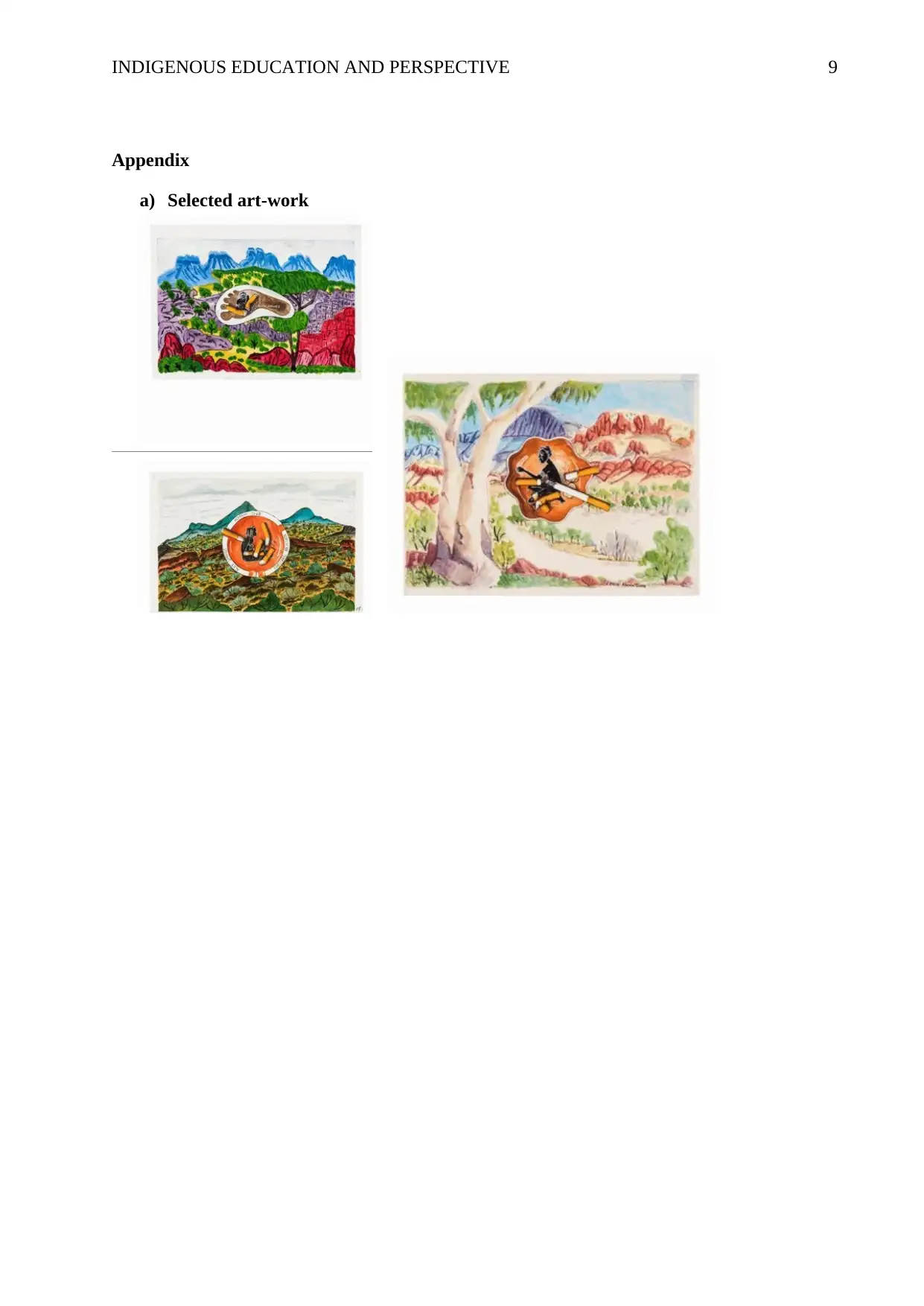
INDIGENOUS EDUCATION AND PERSPECTIVE 9
Appendix
a) Selected art-work
Appendix
a) Selected art-work
1 out of 9
Related Documents
Your All-in-One AI-Powered Toolkit for Academic Success.
+13062052269
info@desklib.com
Available 24*7 on WhatsApp / Email
![[object Object]](/_next/static/media/star-bottom.7253800d.svg)
Unlock your academic potential
© 2024 | Zucol Services PVT LTD | All rights reserved.





